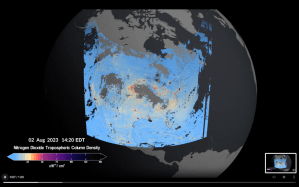SAN FRANCISCO – The first NASA satellite to measure air pollution hourly shows so much promise that space agency officials are already thinking about ways to extend its life. “We want TEMPO to last for 10 years, if possible,” Barry Lefer, NASA tropospheric composition program manager, said Dec. 12 at the American Geophysical Union annual meeting here.
“So, we are going to baby it. ” TEMPO, short for Tropospheric Emissions: Monitoring of Pollution, was sent aloft in April as a hosted payload on Intelsat 40e, a geostationary communications satellite. The instrument, built by Ball Aerospace to measure atmospheric pollution from Canada’s oil sands to the Yucatán Peninsula and from the Atlantic Ocean to the Pacific Ocean, made its first North American scans in early August.
NASA researchers immediately began comparing TEMPO data with airborne measurements of the same locations. Since August, “the TEMPO team has been busy testing out all different parts of the instrument and optimizing that scan pattern,” Lefer said. “The most exciting thing is it’s working incredibly well.
” TEMPO is NASA’s first Earth-observation satellite in geostationary orbit. Previous polar-orbiting satellites provided daily observations. In contrast, TEMPO is providing 10 to 12 daily scans.
“It’s the first time to have the range of spectral data from a geostationary satellite,” said Hazem Mahmoud, an Earth scientist from NASA’s Langley Research Center. “We have been working on development of new software capability to handle this very high temporal resolution data. ” NASA will share data on atmospheric concentrations of nitrogen dioxide, formaldehyde and ozone with the National Oceanic and Atmospheric Administration and the Environmental Protection Agency to improve air quality forecasts.
More than 500 early adopters already have access to TEMPO data. Validated data is scheduled to be released publicly in April. In addition to TEMPO, Ball Aerospace develop and built the Geostationary Environment Monitoring Spectrometer for the South Korean National Institute of Environmental Research.
The two instruments are similar, but TEMPO has fewer redundant parts than GEM, launched in 2020. “TEMPO was a very inexpensive cost-capped mission,” Lefer said. “As a pathfinder, we developed the new technology and proved that it works.
Then we work with NOAA on the next generation. ” NOAA’s Atmospheric Composition Instrument, an improved version of TEMPO, is scheduled to launch sometime in the mid 2030s on a Geostationary Extended Observations satellite over the central United States. TEMPO is designed to operate in orbit for at least 20 months, but NASA officials are hoping it lasts much longer.
Intelsat has assured NASA that it plans to keep TEMPO’s host satellite in orbit for 10 to 15 years. “If the instrument continues to operate, we will continue to collect data for that whole time,” Lefer said. A virtual constellation to monitor air pollution over the Northern Hemisphere will be created by TEMPO, GEMS and the European Space Agency’s Meteosat Third Generation Sounder satellite, scheduled to launch in 2024.
The space agencies are working closely together to jointly calibrate and validate the various instruments. .
From: spacenews
URL: https://spacenews.com/nasa-will-baby-tempo-to-extend-its-life/



